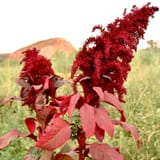Search Results
!!P38zFLDUYUh/x/40785152#40785499
7/24/2025, 5:37:28 AM
>>40785461
>Quinoa, pronounced ‘keen-wa’, is a gluten-free alternative to starchy grains. Although it often occupies a similar role to grains in dishes, quinoa is actually a seed from the same family as beets, chard and spinach. It is high in protein and an important plant source of all nine essential amino acids. Grown in South America (Peru, Chile and Bolivia) for thousands of years, quinoa formed the staple diet of the Incas and their descendants. In recent years, foodies have heralded it as a superior alternative to bulgur wheat, couscous and rice.
>Quinoa (Chenopodium quinoa Willd.) was known as the "golden grain" by the native Andean people in South America, and has been a source of valuable food over thousands of years. It can produce a variety of secondary metabolites with broad spectra of bioactivities. At least 193 secondary metabolites from quinoa have been identified in the past 40 years. They mainly include phenolic acids, flavonoids, terpenoids, steroids, and nitrogen-containing compounds. These metabolites exhibit many physiological functions, such as insecticidal, molluscicidal and antimicrobial activities, as well as various kinds of biological activities such as antioxidant, cytotoxic, anti-diabetic and anti-inflammatory properties.
>Ecdysone is a steroid hormone that is derived from cholesterol and plays a crucial role in mediating developmental transitions.
>Quinoa, pronounced ‘keen-wa’, is a gluten-free alternative to starchy grains. Although it often occupies a similar role to grains in dishes, quinoa is actually a seed from the same family as beets, chard and spinach. It is high in protein and an important plant source of all nine essential amino acids. Grown in South America (Peru, Chile and Bolivia) for thousands of years, quinoa formed the staple diet of the Incas and their descendants. In recent years, foodies have heralded it as a superior alternative to bulgur wheat, couscous and rice.
>Quinoa (Chenopodium quinoa Willd.) was known as the "golden grain" by the native Andean people in South America, and has been a source of valuable food over thousands of years. It can produce a variety of secondary metabolites with broad spectra of bioactivities. At least 193 secondary metabolites from quinoa have been identified in the past 40 years. They mainly include phenolic acids, flavonoids, terpenoids, steroids, and nitrogen-containing compounds. These metabolites exhibit many physiological functions, such as insecticidal, molluscicidal and antimicrobial activities, as well as various kinds of biological activities such as antioxidant, cytotoxic, anti-diabetic and anti-inflammatory properties.
>Ecdysone is a steroid hormone that is derived from cholesterol and plays a crucial role in mediating developmental transitions.
6/22/2025, 8:44:55 PM
Page 1

